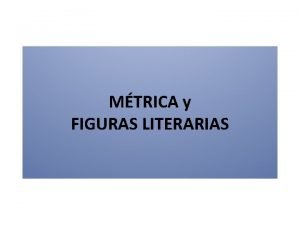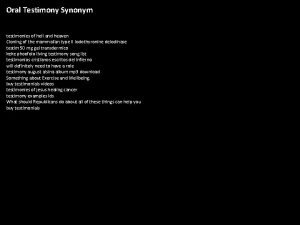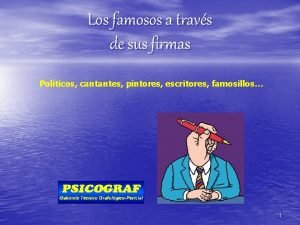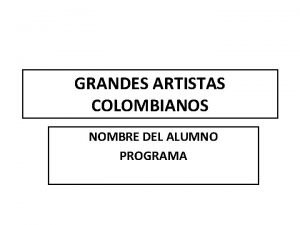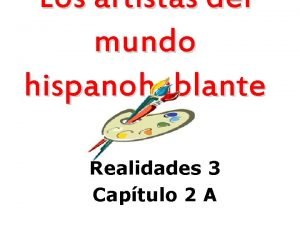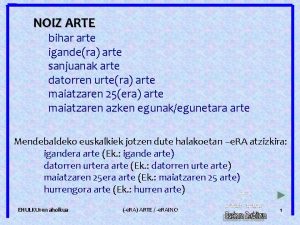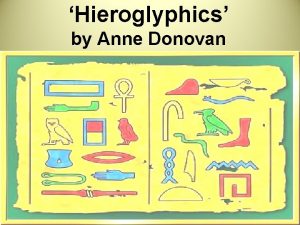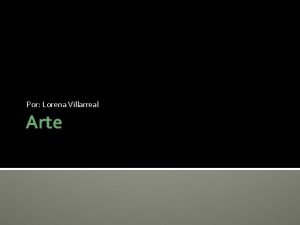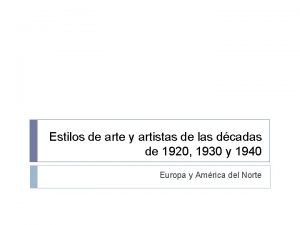ARTE Y ARTISTAS ESPAOLES Por Sinad O Donovan









- Slides: 9

ARTE Y ARTISTAS ESPAÑOLES Por Sinéad O’ Donovan

A LITTLE BIT ABOUT SPANISH ART • Spanish art is the visual art of Spain. • Many famous and influential artists came from Spain including Velázques, Goya and Picasso. • Spanish art has distinctive characteristics that stand out to other pieces of art around the world. • These differences were influenced by the heritage in Spain, and the Counter-Reformation. • Many people say that when you see a Spanish painting it is very easy to tell that it is Spanish because of its topic and type of painting.

DIFFERENT ERA’S IN SPANISH ART 1. Romanesque • In Spain during the era of Romanesque art, art was more popular in the North. • Romanesque art consisted of church frescos, stained glass windows and showing depth in pictures. • Painting altar frontals on wood was also quite popular during the era of Romanesque art. • During Romanesque times churches were covered in paintings. Many of these paintings are destroyed today. The painted crypt of San Isidoro at León, Spain. Apse of Sant Climent de Taüll, a Catalan fresco by the Master of Taüll now in Museu Nacional d'Art de Catalunya.

2. Renaissance • During the Renaissance Spain was influenced hugely by Italian art. • The Italian influence was strongest in Valencia. • Many Spanish artists went to Italy to learn their techniques. • Fernando Yanez de la Almedina and Fernando Llanos were two Spanish artists who went to Italy to learn more about art. • Spanish artists changed theme and spirtual parts of Renaissance paintings to suit Spanish religion. Fernando Yanez de la Almedina painting Fernando Llanos painting

• His most famous pieces of art are Les Demoiselles d'Avignon and Guernica. • Pablo went through different phases in his paintings, these included his blue stage where his paintings were all blue, rose stage where they were a mix of pink and red and his political stage where his paintings were about war and politics. • Pablo died 8 April 1973 at the age of 91. Les Demoiselles d'Avignon Guernica

3. 20 th Century • During the 20 th century many leading Spanish artists worked in Paris. • Art in the 20 th century was more modern. • There was no one particular topic in the 20 th century, portraits and drawing of objects or ideas were very common. • Picasso was a Spanish artist who was one of the leading artists in the 20 th century. Spanish art in the 20 th century

PABLO PICASSO • Pablo Picasso was born in Malaga, Spain in 25 October 1881. • He was a Spanish painter, sculptor, printmaker, ceramicist, and stage designer. • He is known as one of the greatest and most influential artists of the 20 th century. • He co-invented the idea of the collage. • Pablo Picasso is known all around the world for his great pieces.

FRANCISCO GOYA • Francisco Goya was born in Aragon, Spain on 30 th March 1746. • He was a Spanish romantic painter and printmaker. • Goya was a court painter to the Spanish Crown. • Goya was asked to paint King Carlos III portrait. • After he did so he became very popular with the royal family. • His wife died in 1812 at that time he was painting images of the Spanish war.

• Goya’s most famous paintings are The Nude Maja and The Clothed Maja. • They are the same picture of the same woman but she has clothes in one painting and not in the other. • Like Picasso Goya went through different stages in his paintings. 1. Darker subject matter- Dark dramatic, nightmare paintings. 2. The Disasters of War- These were images from the war that Goya painted on tile. 3. Black Paintings- Unusual paintings which were based around witchcraft and war.

